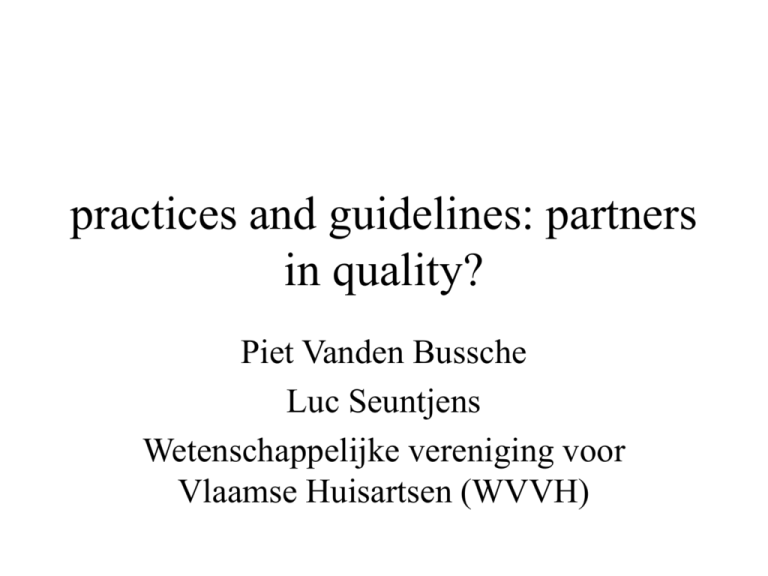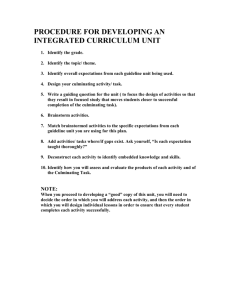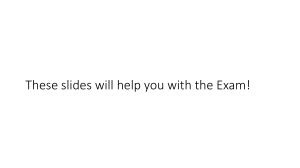The practice and guidelines: partners in quality?
advertisement

practices and guidelines: partners in quality? Piet Vanden Bussche Luc Seuntjens Wetenschappelijke vereniging voor Vlaamse Huisartsen (WVVH) • “ the naive assumption that when research information is made available it is somehow accessed by practitioners, appraised and then applied in practice is now largely discredited. “ Effective health care vol 5 nov 1 1999: Getting evidence into practice What is known? • Interactive workshops can result in moderately large changes - didactic sessions alone are unlikely to change professional practice “ • audit and feedback: effects …can be effective in improving professional practice. The effects are generally small to moderate. ….. are more likely to be larger wen baseline adherence to recommended practice is low.” • there is some evidence that guideline driven care is effective in changing process and outcome of care provided by professions allied to medicine. cochrane library issue 2 2004: Input proces and output • Most research: what are the features of guidelines that are important for implementation • growing research on external support for practices to help implementation • there is very little information about the processing of guidelines within the practices What are Critical Factors in the individual practice? The proces of guideline implementation • • • • • 0: no use of the guideline(s) 1: reading of the guideline(s) 2: discussion of the guideline(s) 3: translation into practice-guideline(s) 4: visable (change in) practice elements “proving” implementation • 5: registration of indicators • 6: evaluation Course in quality management for GP’s • • • • • Day 1: introduction critical incident etc day 2: quality projects day 3: implementation of guidelines day 4: vision mission and group processes day 5: evaluation (practice report) • theory, work shops, home work, intervision • 4 years, 10 to 12 participants Evaluation of day 3 1 structural features in the practice (very high scores) 2 implementation level(0 to 6) of Flemish guidelines (18) 3 what are the critical factors for success or failure? Questionaire to 44 practices / 26 answers Guidelines score NIDDM Use of urgency set cyst it is (f emales) Sore t hoat Ankle dist ort ion smoking cessat ion coughing Cont racept ion Neural t ube def ect 0,0 0,5 1,0 1,5 2,0 2,5 3,0 3,5 Reading and practice change GUIDELINE READ Visible applications in practice NIDDM NIDDM Fal prevention Valpreventie ... Fal prevention Valpreventie ... Contraception/ Anticonceptie Contraception/ Anticonceptie Middle ear infection / Acute ... Middle ear infection / Acute ... Sore thoat/ Acute keelpijn Sore thoat/ Acute keelpijn Influenza Influenza Breatscancer preventi(e)on ... Breatscancer preventi(e)on ... Ankle distortion Enkeldistorsie Ankle distortion Enkeldistorsie Child astma kind Child astma kind Acne Acne tetanos & difterie tetanos & difterie smoking cessation stoppen ... smoking cessation stoppen ... female cystitis vrouw female cystitis vrouw cervicalcancer screening ... cervicalcancer screening ... couphing / Acute hoest couphing / Acute hoest Use of urgency set / ... Use of urgency set / ... Vaginitis & vaginose' Vaginitis & vaginose' Neural tube defect / ... Neural tube defect / ... 0 5 10 15 number practices 20 25 0 2 4 6 Number practices 8 10 What about practices and their capacity to implement guidelines • These are not standaard practices • number of guidelines implemented yearly 0 10 1 8 2 6 3 4 4 5 2 6 0 7 nr guidelines 8 9 onb Types of practices • Poor guideline implementation (38%) • Fair guideline implementation (34%) • High guideline implementation (27%) 71-75 61-65 51-55 41-45 31-35 21-25 11- 15 nr practices 0-5 4 3,5 3 2,5 2 1,5 1 0,5 0 Regression analysis Application of guidelines according to practice type Opleidingspraktijk / teaching practice 0,70 yes / Ja overall application 0,60 nee / no 0,50 • Increasing # of sources 0,40 0,30 r = 0,44 ; Beta 0,58 (CI 0,36 ; 0,78) ; p = 0,02 0,20 • Teaching practices 0,10 0,00 Beta -0,15 (CI -0,28 ; -0,02) p = 0,02 3,00 4,00 5,00 6,00 7,00 8,00 # sources for evidence based med 9,00 Why succesfull? Which guideline is best implemented and why? – Guideline features 23% – Practice features 72% » infrastructure (7.5%) » people (23%) » information (13 %) » finance (0%) » quality and safety (28%) – External support 5% What can help, offer support? • External factors (50%) – – – – (financial) incentives soft ware support peer review reminders and feed back • Guidelines (30%) offering implementation material (leaflets, fow charts,…) • changing Practice features (20%) What problems did you have implementing the guidelines? • Nearly all problems had to do with internal practice functions (87.5%) – lack of financial reward (28%) – problems with the way information is handled (25%) – problems with the quality system not considering this to be a priority (21%) Conclusions: focussing on practices • Practice management is essential and a key for succes in implementing guidelines • training in practice management skills is essential (interactive work shop sessions) participating in teaching is an important stimulating factor • key measures asked by practices are – 1 financial support or rewards – 2 electronic data support measures • we have to validate the instrument we used for measuring implementation of guidelines but measuring this enables to give feed back and make practices aware of their capacity to implement guidelines For guideline makers • Don’t make to many guidelines at a time and set priorities • guidelines on practice management items can be very succesfull • preventive topics are easier to implement then others • topics on well defined clear cut problems are easier to implement • Implementation and the level of implementation are primarly influenced by practice features. • Measurement of the implementation is an important en valid way of measuring quality in practices. • A shift of interest and financing from making guidelines to supporting practices in order to make implementation succesfull is necessary






